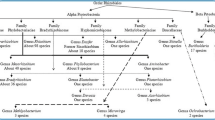Summary
A survey was made of published results of tests of the capacity of Rhizobium derived from one legume genus to nodulate plants from other genera. The data were derived from more than 14,000 separate cross-inoculation trials involving species from 165 genera of legumes. Numerical taxonomic techniques were applied to 113 of the genera for which results of substantial cross-infection tests were available. The data were examined using mean character difference coefficients re-expressed as total and positive-only similarity coefficients. The resulting similarity matrices were clustered by the unweighted pair-group method using arithmetic averages. Eighteen affinity groups were defined at the 70% similarity level. With few exceptions, the physiological and cultural behavior of the rhizobia was consistent within the defined groups. Two broad categories were suggested in the numerical taxonomic analysis, and their validity is discussed in regard to the geographic, physiological and cultural characteristics of the legumes and their Rhizobium microsymbionts. The taxonomic and agronomic value of this approach and the new groupings are discussed.
Similar content being viewed by others
References
Allen O N and Allen E K 1939 root-nodule bacteria of some tropical leguminous plants: II. Cross-inoculation tests within the cowpea group. Soil Sci. 47, 63–76.
Allen O N and Allen E K 1981 The Leguminosae. Univ. of Wisconsin Press, Madison, Wisc.
Bushnell O A and Sarles W B 1937 Attempts to differentiate the species of Rhizobium by physiological methods. J. Bacteriol. 33, 81–82.
Capitaine L 1912 Étude Analytique et Phytogéographique du Groupe des Légumineuses. Paul Lechevalier, Paris.
DeLey J and Rassel A 1965 DNA base composition, flagellation and taxonomy of the genus Rhizobium. J. Gen. Microbiol. 41, 85–91.
Fred E B, Baldwin I L and McCoy E 1932 Root Nodule Bacteria and Leguminous Plants. Univ. of Wisconsin Press, Madison, Wisc.
Graham P H 1964 The application of computer techniques to the taxonomy of the rootnodule bacteria of legumes. J. Gen. Microbiol. 35, 511–517.
Habish H A and Khairi S M 1968 Nodulation of legumes in the Sudan: cross-inoculation groups and the associated Rhizobium strains. Expt. Agric. 4, 227–234.
Hollis A B, Kloos W E and Elkan G H 1981 DNA∶DNA hybridization studies ofRhizobium japonicum and related Rhizobiaceae. J. Gen. Microbiol. 123, 215–22.
Jarvis B D W 1983 Genetic diversity of Rhizobium strains which nodulateLeucaena leucocephala. Curr. Microbiol. 8, 153–158.
Jarvis B D W, Dick A G and Greenwood R M 1980 Deoxyribonucleic acid homology among strains ofRhizobium trifolii and related species. Intl. J. System Bacteriol. 30, 42–52.
Jarvis B D W, MacLean T A, Robertson I G C and Fanning G R 1977 Phenetic similarity and DNA base sequence homology of root nodule bacteria from New Zealand native legumes and Rhizobium strains from agricultural plants. N.Z.J. Agric. Res. 20, 235–248.
Jarvis B D W, Pankhurst C E and Patel J J 1982Rhizobium loti, a new species of legume root nodule bacteria. Intl. J. System. Bacteriol. 32, 378–380.
Jensen H L 1958 The classification of the rhizobia.In Nutrition of the legumes. Ed. E G Hallsworth. Butterworths Scientific Publications, London, pp 75–86.
Jensen H L 1963 Relations de la plante hote avec les Rhizobium du groupeLotus-Anthyllis. Ann. Inst. Pasteur 105, 232–236.
Johnson M D and Allen O N 1952 Cultural reactions of rhizobia with special reference to strains isolated fromSesbania species. Antonie van Leewenhoek J. Microbiol. Serol. 18, 1–12.
Jordan D C 1982 Transfer ofRhizobium japonicum Buchanan 1980 to Bradyrhizobium gen. nov., a genus of slow-growing, root nodule bacteria from leguminous plants. Intl. J. System. Bacteriol. 32, 136–139.
Keyser H H, Bohlool B B, Hu T S and Weber D F 1982 Fast-growing rhizobia isolated from root nodules of soybean. Science 215, 1631–1632.
Krieg N R Ed. Bergey's Manual of Determinative Bacteriology. Vol. 1, Williams and Wilkins Co., Baltimore, Md.
Lange R T 1961 Nodule bacteria associated with the indigenous Leguminosae of South-Western Australia. J. Gen. Microbiol. 26, 351–359.
Lindström K, Jarvis B D W, Lindström P E and Patel J J 1983 DNA homology, phagetyping, and cross-nodulation studies of rhizobia infectingGalega species. Can. J. Microbiol. 29, 781–789.
Mannetje L't 1967 A re-examination of the taxonomy of the genus Rhizobium and related genera using numerical analysis. Antonie van Leeuwenhoek J. Microbiol. Serol. 33, 477–491.
Moffett M L and Colwell R R 1968 Adansonian analysis of the Rhizobiaceae. J. Gen. Microbiol. 51, 245–266.
Norris D O 1965 Acid production by Rhizobium. A unifying concept. Plant and Soil 22, 143–166.
Roberts G P, Leps W T, Silver L E and Brill W J 1980 Use of two-dimensional polyacrylamide gel electrophoresis to identify and classify Rhizobium strains. Appl. Environ. Microbiol. 39, 414–422.
Sneath P H and Sokal R R 1973 Numerical Taxonomy: The Principles and Practice of Numerical Classification. W H Freeman, San Francisco.
Trinick M J 1980 Relationships amongst the fast-growing rhizobia ofLablab purpureus, Leucaena leucocephala, Mimosa spp.,Acacia farnesiana andSesbania grandiflora and their affinities with other rhizobial groups. J. Appl. Bacteriol. 49, 39–53.
Trinick M J 1982 Host-Rhizobium associations.In Nitrogen Fixation in Legumes. Ed J M Vincent. Academic Press, New York, pp. 111–122.
Trinick M J and Galbraith J 1980 The Rhizobium requirements of the non-legume Parasponia in relationship to the cross-inoculation group concept of legumes. New Phytol. 86, 17–26.
Tutin T G 1958 Classification of the legumes.In Nutrition of the Legumes. Ed E G Hallsworth. Butterworths Scientific Publications, London, pp 3–14.
Vincent J M and Humphrey B 1970 Taxonomically significant group antigens in Rhizobium. J. Gen. Microbiol. 63, 379–382.
Wilson J K 1939 Leguminous plants and their associated organisms. Cornell Univ. Agric. Exp. Station Memoir 221, Ithaca, New York.
Zablotowicz R M 1978 Characterization, ecology, and physiology of the cowpea Rhizobium. Ph. D. Thesis, Univ. of California, Riverside, Calif.
Author information
Authors and Affiliations
Rights and permissions
About this article
Cite this article
Lieberman, M.T., Mallory, L.M., Simkins, S. et al. Numerical taxonomic analysis of cross-inoculation patterns of legumes and Rhizobium. Plant Soil 84, 225–244 (1985). https://doi.org/10.1007/BF02143186
Received:
Revised:
Issue Date:
DOI: https://doi.org/10.1007/BF02143186




